Getting Started with Windows Forms Pivot Grid
21 Jan 202524 minutes to read
Important
Starting with v16.2.0.x, if you refer to Syncfusion® assemblies from trial setup or from the NuGet feed, include a license key in your projects. Refer to this link to learn about registering Syncfusion® license key in your Windows Forms application to use our components.
This section provides a quick overview for working with the pivot grid for WinForms. Walk through the entire process of creating a simple pivot grid.
Assembly deployment
Refer control dependencies section to get the list of assemblies or NuGet package needs to be added as reference to use the pivot grid control in any application.
Creating application with pivot grid
This section explains how to add the pivot grid control in Windows Forms application.
Adding control via designer
The WinForms Pivot Grid control can be added through designer by following the below steps.
-
Create a new Windows Forms Application in Visual Studio.
-
Drag and drop the pivot grid control from the toolbox into the designer page.

- Then, the pivot grid control will be successfully added into the application along with the required libraries.

Adding control via code
The pivot grid control can be added through code-behind by following the below steps.
-
Create a new Windows Forms Application in Visual Studio.
-
Add the following assembly references to the project.
- Syncfusion.Grid.Windows.dll
- Syncfusion.PivotAnalysis.Base.dll
- Syncfusion.PivotAnalysis.Windows.dll
- Syncfusion.Shared.Base.dll
-
Then initialize the pivot grid control by creating an instance and add it to the form using the code specified below.
//Initialize a new pivot grid.
Syncfusion.Windows.Forms.PivotAnalysis.PivotGridControl pivotGridControl1 = new Syncfusion.Windows.Forms.PivotAnalysis.PivotGridControl();
// Add required size for the pivot grid control
pivotGridControl1.Size = new System.Drawing.Size(344, 250);
// Add the pivot grid control to the parent control.
this.Controls.Add(pivotGridControl1);'Initialize a new pivot grid.
Dim pivotGridControl1 As New Syncfusion.Windows.Forms.PivotAnalysis.PivotGridControl()
' Add required size for the pivot grid control
pivotGridControl1.Size = New System.Drawing.Size(344, 250)
' Add the pivot grid control to the parent control.
Me.Controls.Add(pivotGridControl1)Adding control via Syncfusion® reference manager
Syncfusion® reference manager is a Visual Studio Add-In that helps to add Syncfusion® controls. The pivot grid control can be added through Syncfusion® reference manager by following the below steps.
-
Create a new Windows Forms Application in Visual Studio.
-
Then right-click on the project and select Syncfusion® Reference Manager.

- The Syncfusion® Reference Manager wizard will be opened as shown below.
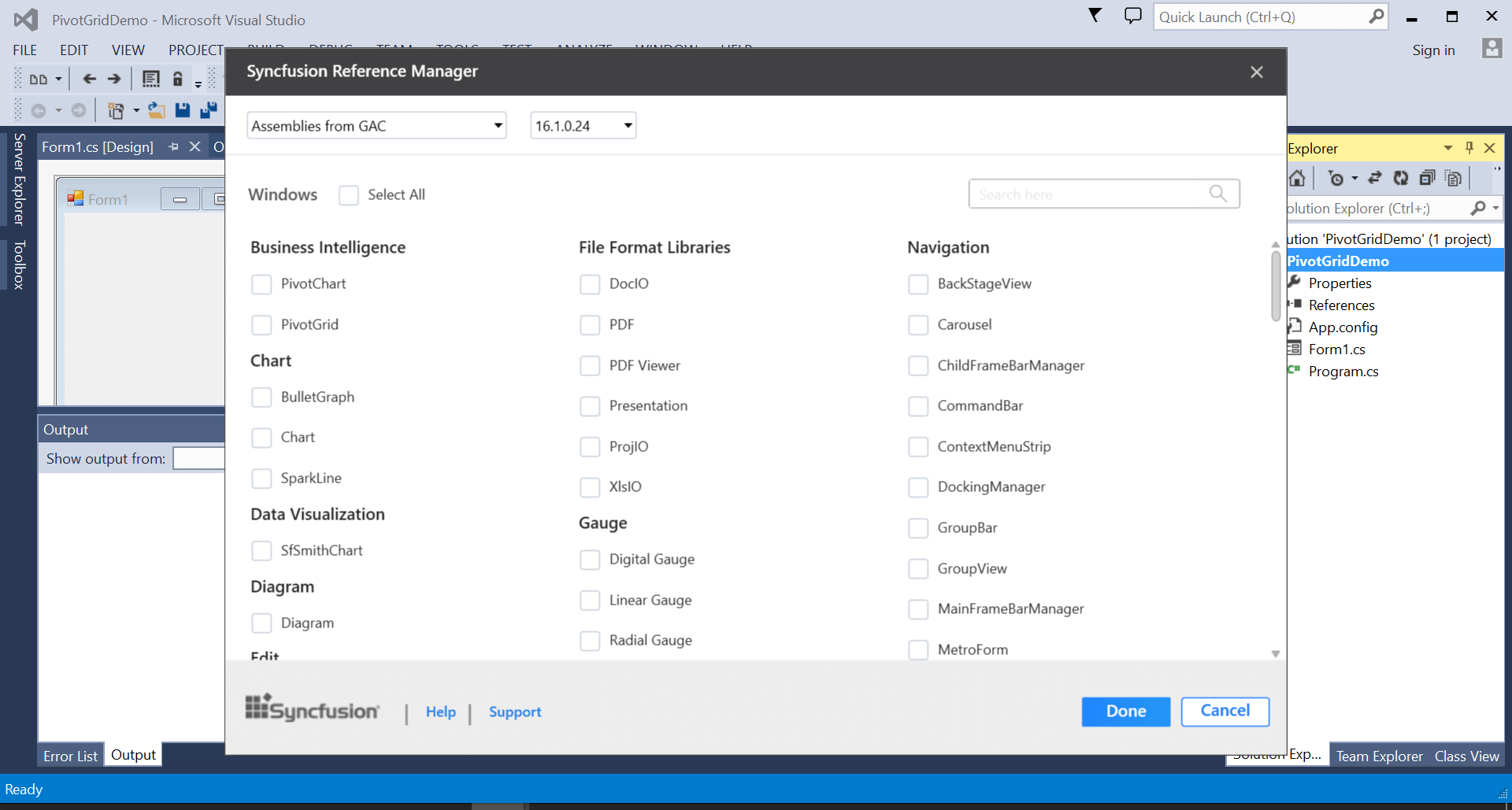
- Select the pivot grid control by searching it using search box. Then click on done button to add the selected pivot grid control.
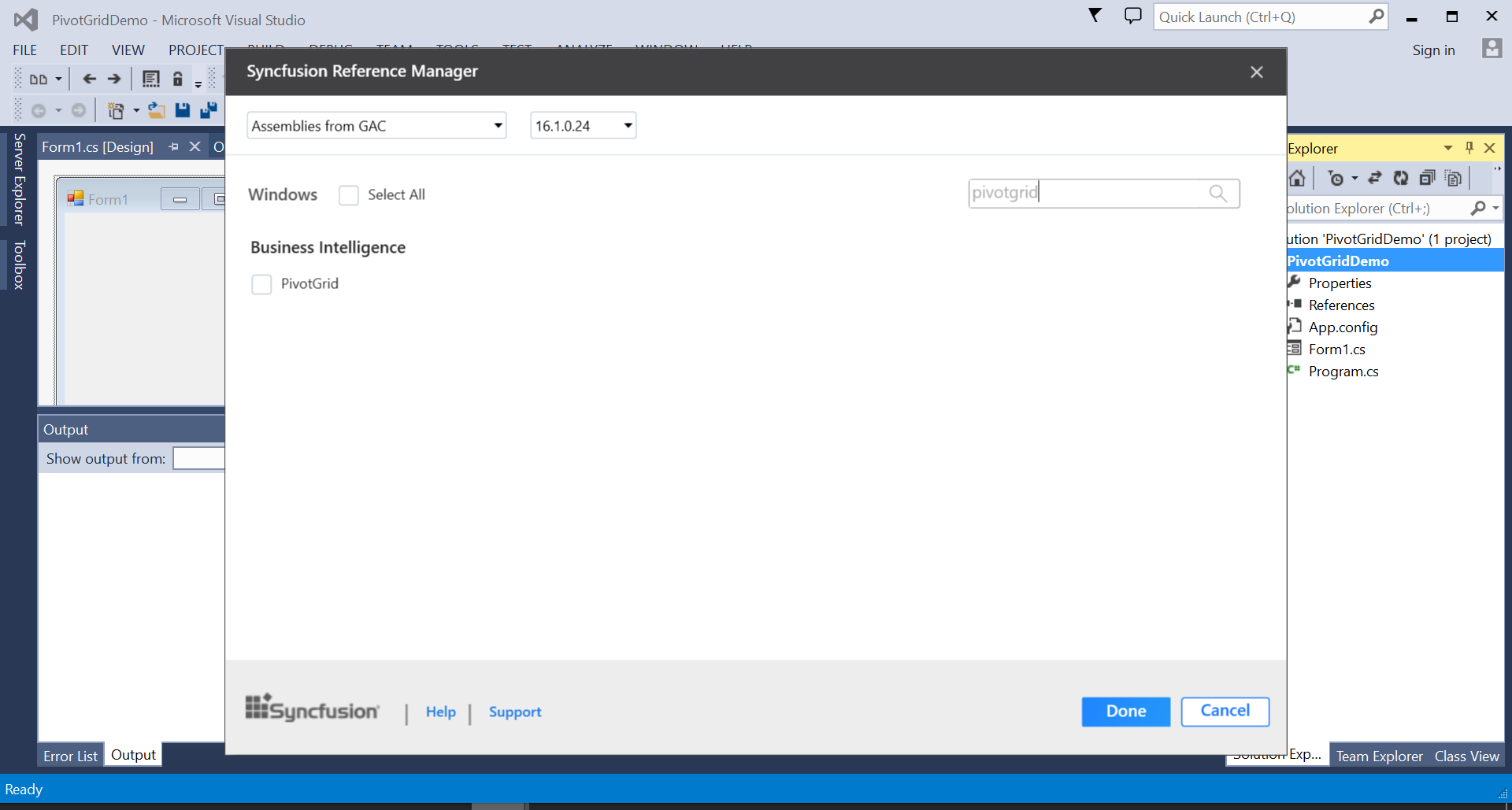
- The required assemblies will be automatically added to the project by clicking ok button.
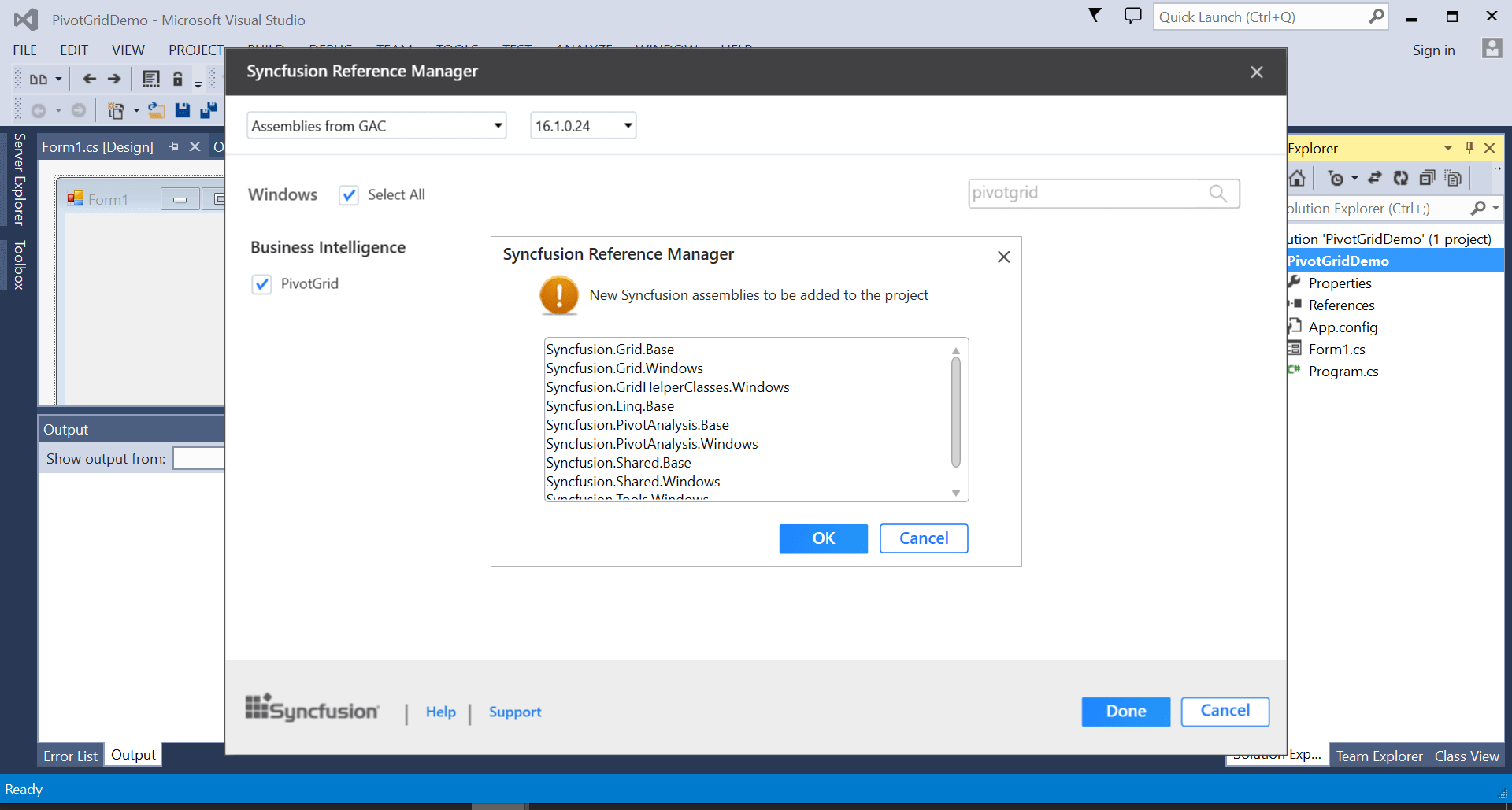
- Add the following code sample in code behind to create a simple pivot grid control.
//Initialize a new pivot grid.
Syncfusion.Windows.Forms.PivotAnalysis.PivotGridControl pivotGridControl1 = new Syncfusion.Windows.Forms.PivotAnalysis.PivotGridControl();
// Add required size for the pivot grid control
pivotGridControl1.Size = new System.Drawing.Size(344, 250);
// Add the pivot grid control to the parent control.
this.Controls.Add(pivotGridControl1);'Initialize a new pivot grid.
Dim pivotGridControl1 As New Syncfusion.Windows.Forms.PivotAnalysis.PivotGridControl()
' Add required size for the pivot grid control
pivotGridControl1.Size = New System.Drawing.Size(344, 250)
' Add the pivot grid control to the parent control.
Me.Controls.Add(pivotGridControl1)NOTE
Syncfusion® reference manager supports for specific framework which is shipped (assemblies) in our Syncfusion® Essential Studio® setup. So, if you try to add Syncfusion® assemblies in project and framework which is not supported with selected Syncfusion® version assemblies, then the dialog will be appeared by specifying that “Current build v{version} is not supported this framework v{Framework Version}”.
Binding data
This section guides you on how to bind data source and its appropriate fields to a pivot grid control. The data source assigned to the pivot grid control should either be an IEnumerable list or a DataView.
In this example, IEnumerable list is used as data source for the pivot grid control and the sample data source contains properties like Product, Date, Country, State, Quantity, Amount, UnitPrice and TotalPrice for demonstration purpose.
public class ProductSales
{
public string Product { get; set; }
public string Date { get; set; }
public string Country { get; set; }
public string State { get; set; }
public int Quantity { get; set; }
public double Amount { get; set; }
public double UnitPrice { get; set; }
public double TotalPrice { get; set; }
public static ProductSalesCollection GetSalesData()
{
// Geography
string[] countries = new string[] { "Australia", "Canada", "France", "Germany", "United Kingdom", "United States" };
string[] states1 = new string[] { "New South Wales", "Queensland", "South Australia", "Tasmania", "Victoria" };
string[] states2 = new string[] { "Alberta", "British Columbia", "Brunswick", "Manitoba", "Ontario", "Quebec" };
string[] states3 = new string[] { "Charente Maritime", "Essonne", "Garonne (Haute)", "Gers", };
string[] states4 = new string[] { "Munich", "Brandenburg", "Hamburg", "Hessen", "Nordrhein Westfalen", "Saarland" };
string[] states5 = new string[] { "England" };
string[] states6 = new string[] { "New York", "North Carolina", "Alabama", "California", "Colorado", "New Mexico", "South Carolina" };
// Time
string[] dates = new string[] { "FY 2005", "FY 2006", "FY 2007", "FY 2008", "FY 2009" };
// Products
string[] products = new string[] { "Bike", "Car" };
Random r = new Random(123345345);
int numberOfRecords = 2000;
ProductSalesCollection listOfProductSales = new ProductSalesCollection();
for (int i = 0; i < numberOfRecords; i++)
{
ProductSales sales = new ProductSales();
sales.Country = countries[r.Next(1, countries.GetLength(0))];
sales.Quantity = r.Next(1, 12);
/// 1 percent discount for 1 quantity
double discount = (30000 * sales.Quantity) * (double.Parse(sales.Quantity.ToString()) / 100);
sales.Amount = (30000 * sales.Quantity) - discount;
sales.TotalPrice = sales.Amount * sales.Quantity;
sales.UnitPrice = sales.Amount / sales.Quantity;
sales.Date = dates[r.Next(r.Next(dates.GetLength(0) + 1))];
sales.Product = products[r.Next(r.Next(products.GetLength(0) + 1))];
switch (sales.Country)
{
case "Australia":
{
sales.State = states1[r.Next(states1.GetLength(0))];
break;
}
case "Canada":
{
sales.State = states2[r.Next(states2.GetLength(0))];
break;
}
case "France":
{
sales.State = states3[r.Next(states3.GetLength(0))];
break;
}
case "Germany":
{
sales.State = states4[r.Next(states4.GetLength(0))];
break;
}
case "United Kingdom":
{
sales.State = states5[r.Next(states5.GetLength(0))];
break;
}
case "United States":
{
sales.State = states6[r.Next(states6.GetLength(0))];
break;
}
}
listOfProductSales.Add(sales);
}
return listOfProductSales;
}
//Retrieve the item source from the ProductSalesCollection
public class ProductSalesCollection : List<ProductSales>
{
}
}Public Class ProductSales
Public Property Product As String
Public Property Date As String
Public Property Country As String
Public Property State As String
Public Property Quantity As Integer
Public Property Amount As Double
Public Property UnitPrice As Double
Public Property TotalPrice As Double
Public Shared Function GetSalesData() As ProductSalesCollection
Dim countries As String() = New String() {"Australia", "Canada", "France", "Germany", "United Kingdom", "United States"}
Dim states1 As String() = New String() {"New South Wales", "Queensland", "South Australia", "Tasmania", "Victoria"}
Dim states2 As String() = New String() {"Alberta", "British Columbia", "Brunswick", "Manitoba", "Ontario", "Quebec"}
Dim states3 As String() = New String() {"Charente Maritime", "Essonne", "Garonne (Haute)", "Gers"}
Dim states4 As String() = New String() {"Munich", "Brandenburg", "Hamburg", "Hessen", "Nordrhein Westfalen", "Saarland"}
Dim states5 As String() = New String() {"England"}
Dim states6 As String() = New String() {"New York", "North Carolina", "Alabama", "California", "Colorado", "New Mexico", "South Carolina"}
Dim dates As String() = New String() {"FY 2005", "FY 2006", "FY 2007", "FY 2008", "FY 2009"}
Dim products As String() = New String() {"Bike", "Car"}
Dim r As Random = New Random(123345345)
Dim numberOfRecords As Integer = 2000
Dim listOfProductSales As ProductSalesCollection = New ProductSalesCollection()
For i As Integer = 0 To numberOfRecords - 1
Dim sales As ProductSales = New ProductSales()
sales.Country = countries(r.[Next](1, countries.GetLength(0)))
sales.Quantity = r.[Next](1, 12)
Dim discount As Double =(30000 * sales.Quantity) * (Double.Parse(sales.Quantity.ToString()) / 100)
sales.Amount =(30000 * sales.Quantity) - discount
sales.TotalPrice = sales.Amount * sales.Quantity
sales.UnitPrice = sales.Amount / sales.Quantity
sales.Date = dates(r.[Next](r.[Next](dates.GetLength(0) + 1)))
sales.Product = products(r.[Next](r.[Next](products.GetLength(0) + 1)))
Select Case sales.Country
Case "Australia"
sales.State = states1(r.[Next](states1.GetLength(0)))
Exit Select
Case "Canada"
sales.State = states2(r.[Next](states2.GetLength(0)))
Exit Select
Case "France"
sales.State = states3(r.[Next](states3.GetLength(0)))
Exit Select
Case "Germany"
sales.State = states4(r.[Next](states4.GetLength(0)))
Exit Select
Case "United Kingdom"
sales.State = states5(r.[Next](states5.GetLength(0)))
Exit Select
Case "United States"
sales.State = states6(r.[Next](states6.GetLength(0)))
Exit Select
End Select
listOfProductSales.Add(sales)
Next
Return listOfProductSales
End Function
Public Class ProductSalesCollection
Inherits List(Of ProductSales)
End Class
End ClassNOTE
ProductSalesis a class that consists ofIListdata. For more information, refer the Getting Started demo sample which is located in the following location.
<Installed Drive>\Users\Public\Documents\Syncfusion\Windows\<Version Number>\PivotGrid.Windows\Samples\Getting Started\Getting Started Demo
The pivot grid control requires the following information in order to populate the data from the data source.
- ItemSource - The data source for the pivot table. This object should be either an IEnumerable list or a DataTable.
- PivotRows - Elements that need to be added in rows of pivot grid control.
- PivotColumns - Elements that need to be added in columns of pivot grid control.
- PivotCalculations - Calculation values that need to be added as value cells in pivot grid control.
The below code sample illustrates how to bind data source to the pivot grid control.
this.pivotGridControl1.ItemSource = ProductSales.GetSalesData();Me.pivotGridControl1.ItemSource = ProductSales.GetSalesData()Defining pivot rows
The below code sample illustrates how to define pivot row items for the pivot grid control.
this.pivotGridControl1.PivotRows.Add(new PivotItem { FieldMappingName = "Product", TotalHeader = "Total" });
this.pivotGridControl1.PivotRows.Add(new PivotItem { FieldMappingName = "Year", TotalHeader = "Total" });Me.pivotGridControl1.PivotRows.Add(New PivotItem With {.FieldMappingName = "Product", .TotalHeader = "Total"})
Me.pivotGridControl1.PivotRows.Add(New PivotItem With {.FieldMappingName = "Year", .TotalHeader = "Total"})Defining pivot columns
The below code sample illustrates how to define pivot column items for the pivot grid control.
this.pivotGridControl1.PivotColumns.Add(new PivotItem { FieldMappingName = "Country", TotalHeader = "Total" });
this.pivotGridControl1.PivotColumns.Add(new PivotItem { FieldMappingName = "State", TotalHeader = "Total" });Me.pivotGridControl1.PivotColumns.Add(New PivotItem With {.FieldMappingName = "Country", .TotalHeader = "Total"})
Me.pivotGridControl1.PivotColumns.Add(New PivotItem With {.FieldMappingName = "State", .TotalHeader = "Total"})Defining pivot calculations
The below code sample illustrates how to define pivot calculation information for the pivot grid control.
this.pivotGridControl1.PivotCalculations.Add(new PivotComputationInfo { FieldName = "Amount", Format = "C", SummaryType = SummaryType.DoubleTotalSum });
this.pivotGridControl1.PivotCalculations.Add(new PivotComputationInfo { FieldName = "Quantity", Format = "#,##0" });Me.pivotGridControl1.PivotCalculations.Add(New PivotComputationInfo With {.FieldName = "Amount", .Format = "C", .SummaryType = SummaryType.DoubleTotalSum})
Me.pivotGridControl1.PivotCalculations.Add(New PivotComputationInfo With {.FieldName = "Quantity", .Format = "#,##0"})Finally, run the application to obtain the following output.

Pivot schema designer
Pivot schema designer is a layout which is designed to perform like as Microsoft Excel’s pivot table field list. It allows you to drag-and-drop fields between different areas, including column, row, value and filter. This pivot schema designer can be enabled in pivot grid control by setting the ShowPivotTableFieldList property to true.
// Shows the pivot schema designer.
this.pivotGridControl1.ShowPivotTableFieldList = true;' Shows the pivot schema designer.
Me.pivotGridControl1.ShowPivotTableFieldList = TrueFor more information, refer the pivot schema designer topic.
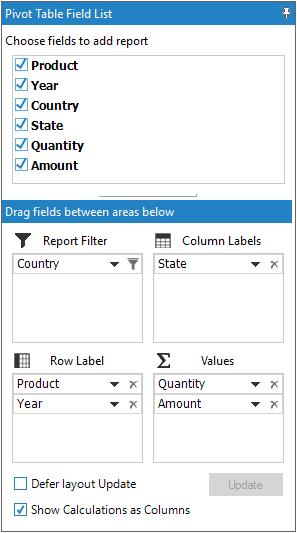
Grouping bar
Grouping bar which allows you to drag and drop fields between different areas such as column, row, value and filter. For enabling the grouping bar, you have to make use of the ShowGroupBar property.
// Enables grouping bar.
this.pivotGridControl1.ShowGroupBar = true;' Enables grouping bar.
Me.pivotGridControl1.ShowGroupBar = True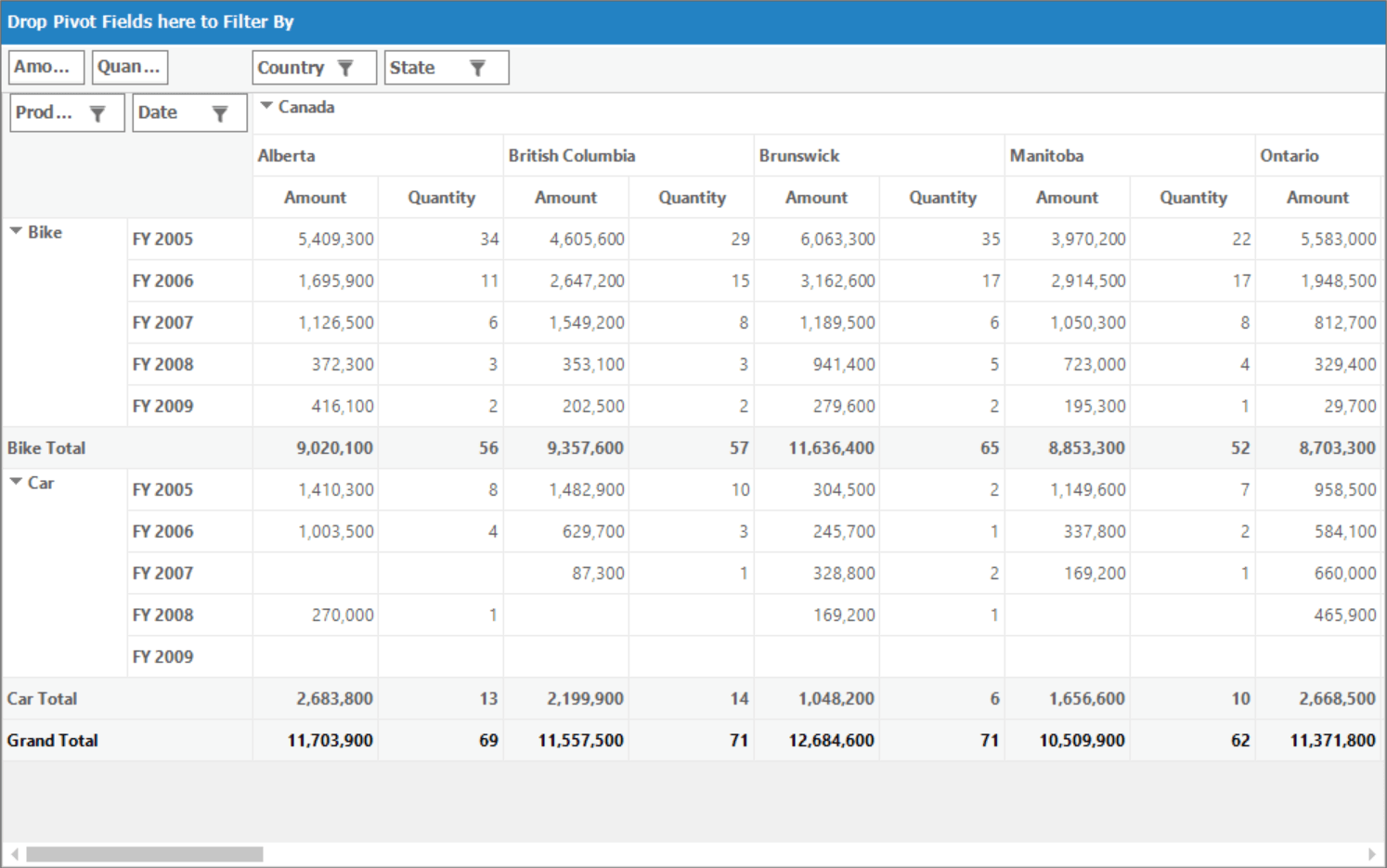
For more information, refer the grouping bar topic.
Filtering
Filtering can be enabled or disabled in pivot grid control by using the AllowFiltering property. You can apply filters to one or more columns.
// Enables filtering in pivot grid control.
this.pivotGridControl1.AllowFiltering = true;' Enables filtering in pivot grid control.
Me.pivotGridControl1.AllowFiltering = True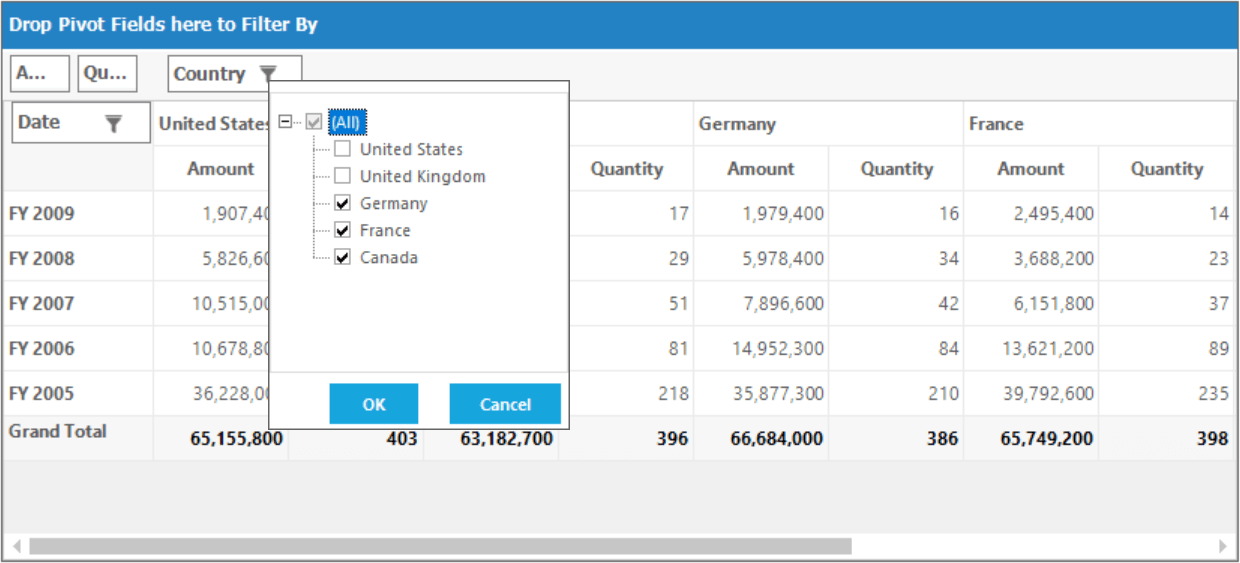
Sorting
Sorting can be enabled or disabled by using the AllowSorting property. By default, the pivot grid control populates the data in ascending order.
// Enables sorting in pivot grid control.
this.pivotGridControl1.AllowSorting = true;' Enables sorting in pivot grid control.
Me.pivotGridControl1.AllowSorting = True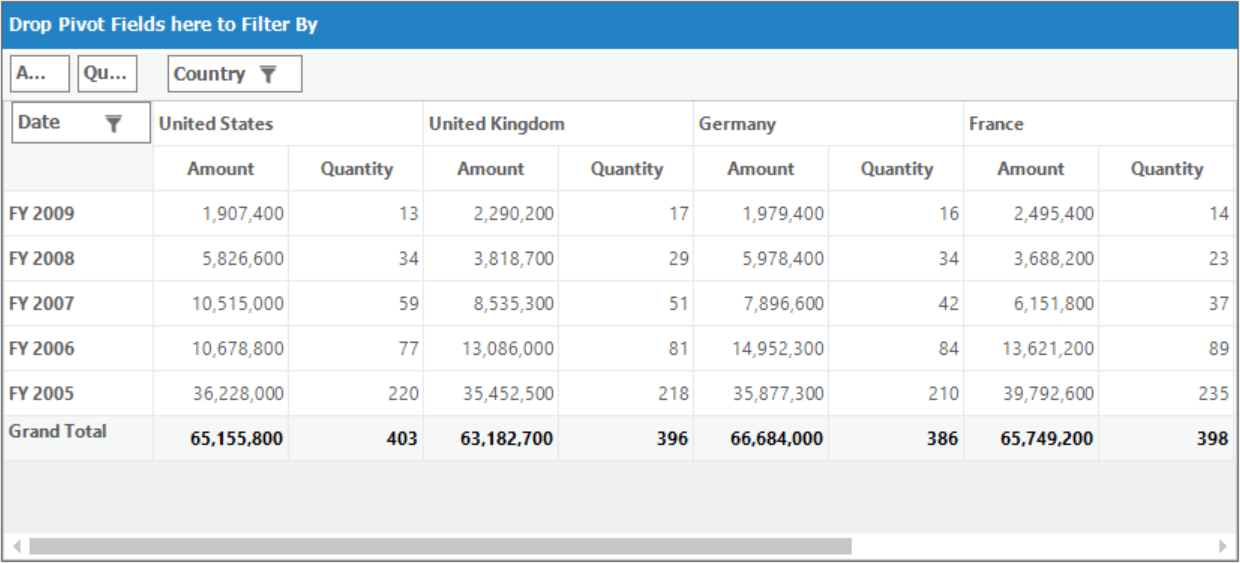
NOTE
You can also explore our WinForms Pivot Grid example that shows you how to render and configure the pivot grid.